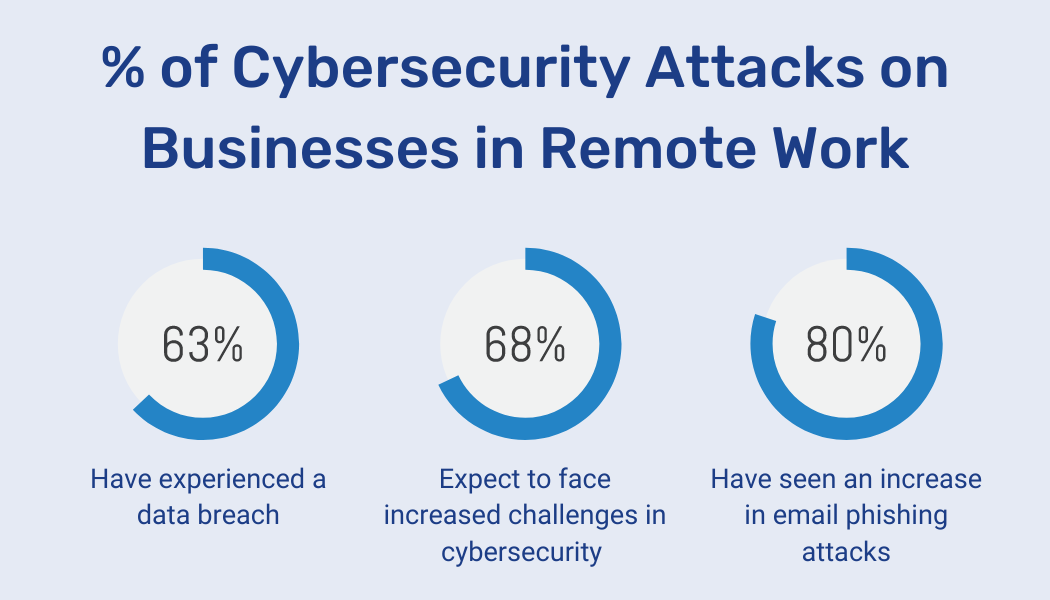
Author: Kysha Praciak
· 2 mins read · 537 views
5 Cybersecurity Challenges in Remote Work
Introduction
In recent years, the landscape of our working environment has undergone a significant transformation, and the shift towards remote work, accelerated by global events, has brought about a new era of flexibility and connectivity. However, this transition also introduces a myriad of cybersecurity challenges, as we navigate through this digital era, understanding and mitigating these risks is paramount to ensure the safety and integrity of our data and systems.

Cybersecurity Challenges in Remote Work
- Network Security: Remote work often relies on personal or public Wi-Fi networks, which are not as secure as corporate networks. This makes it easier for cybercriminals to intercept sensitive data.
- Phishing Attacks: With the increase in remote work, there’s been a surge in phishing attacks. Employees working from home may be more susceptible to these attacks due to the lack of a secure office environment.
- Use of Personal Devices: The use of personal devices for work-related tasks can pose significant security risks, as these devices may not have the same level of security as corporate devices and can be a gateway for cyber threats.
- Data Privacy: Ensuring the privacy of sensitive data becomes more challenging when employees are accessing and storing data on their personal devices or over unsecured networks.
- Lack of In-Person IT Support: Remote workers often lack immediate access to IT support, which can delay the resolution of security issues and increase the risk of breaches.
IT Security Solutions
To combat these challenges, businesses must implement robust IT security solutions:
- Secure Network Connections: Encourage the use of Virtual Private Networks (VPNs) and ensure that employees are connecting to secure and password-protected networks.
- Regular Software Updates and Patch Management: Ensure that all devices and software are kept up-to-date with the latest security patches and updates.
- Multi-Factor Authentication (MFA): Implement MFA to add an extra layer of security, ensuring that only authorized users can access sensitive data and systems.
- Cybersecurity Training: Conduct regular training sessions to make employees aware of the latest phishing scams and teach them best practices for maintaining cybersecurity.
- Endpoint Protection: Utilize comprehensive antivirus and anti-malware solutions, and ensure that regular system scans are conducted.
- Data Encryption: Encrypt sensitive data both at rest and in transit to protect it from unauthorized access.
- Regular Backups: Maintain regular backups of critical data to prevent loss in the event of a cybersecurity incident.
- Access Controls: Implement strict access controls and adhere to the principle of least privilege, ensuring that employees have access only to the data and systems necessary for their work.
Conclusion
As the trend towards remote work continues to grow, so does the importance of robust cybersecurity measures. By understanding the unique challenges posed by remote work and implementing comprehensive IT security solutions, businesses can protect themselves against cyber threats and ensure a secure and productive working environment. It’s not just about technology; it’s about fostering a culture of cybersecurity awareness and vigilance.
Looking for Expert IT Solutions?
Subscribe to Our Newsletter for Exclusive Tips and Updates!
Stay ahead of tech challenges with expert insights delivered straight to your inbox. From solving network issues to enhancing cybersecurity and streamlining software integration, our newsletter offers practical advice and the latest IT trends. Sign up today and let us help you make technology work seamlessly for your business!
Additional Resources
For more insights and guidance on cybersecurity, visit our blog or explore our services.
References:
Lorena Castillo. 2023. Remote Work Cybersecurity Statistics [Fresh Research]. Gitnux. Remote Work Cybersecurity Statistics [Fresh Research]



Share